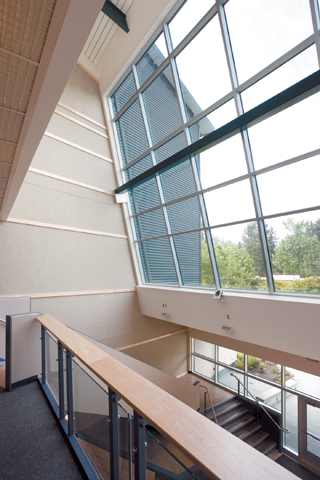
DJC.COM
August 28, 2008
A science building that goes easy on energy
DLR Group

Mason
|

Johnson
|
When Green River Community College chose to build the new Marv Nelson Science Learning Center, its vision was to create a building that supports and celebrates science education and sustainability.
This presented the design team with a distinct challenge: Science lab spaces involve stringent health and safety requirements that often increase energy needs.
The resulting design combined simple building organization ideas with innovative systems that allow sustainable processes to occur and to be expressed.
Sustainable strategies
The Green River campus envelops visitors in woodland. In designing the new center, the project team determined that the building should complement that campus character.
The building is arranged in three stories, minimizing the footprint and thus its impact on the site. The building plan places labs at the center of the building, bookended by two wings of classroom, administrative and informal gathering space.
Co-locating the labs at the core allowed the team to stack them vertically in ascending orders of complexity. The simple, elegant organization of the building allowed for the sharing of utilities systems between the labs, and the more efficient and effective operation of those systems.

Photo by Steve Keating Photography
Extensive glazing allows lots of natural light into the science building at Green River Community College. Solar shading helps control the glare.
|
In strategizing design solutions for the laboratories, the team implemented Labs 21 recommendations and best practices related to energy consumption and system safety. (Labs 21 is a voluntary partnership program sponsored by the U.S. Department of Energy, U.S. Environmental Protection Agency and the International Institute for Sustainable Labor.) Puget Sound Energy awarded a grant for beating local energy code requirements by 30 percent.
The lab ventilation system, which uses a heat recovery system for all fume hood exhaust, captures heat while exhausting pollutants, and works as either a heat source or heat sink as conditions warrant.
For user safety and comfort, science labs typically require eight to 12 air changes per hour. (For comparison, consider that an office typically processes one to three air changes an hour.) Using variable air volume and space occupancy sensors, the system reduces air changes to six per hour for further energy savings.
Additional energy savings were gained by the building’s co-location with Green River’s existing Technology Center. This adjacency allowed both buildings to share mechanical systems, including high-efficiency boilers.
Fitting into surroundings
The design of the building allows it to nestle into the forested campus. The smaller footprint allowed for the preservation of all trees on the site, and maximizes site permeability and natural water cycling. Detention ponds were crafted as rain gardens, while additional plantings included native and drought-tolerant species to minimize water demand and the use of maintenance chemicals.
Seen from the outside, the building appears to grow from the ground, with the two bookend wings reaching out in an embrace of the landscape.
From the inside, users experience direct connection to the campus. Extensive glazing provides views of the natural surroundings and abundant natural light. Solar shading is used to control glare and to darken rooms when necessary for instruction.
The design integrates durable materials appropriate to science lab conditions, using regionally available products, low-emitting materials and recycled materials: marmoleum and concrete flooring, composite board wainscoting and accents, and tackable surfaces composed of recycled rubber for display use.
Science showcase
| Marv Nelson Science Learning Center |
|
Green River Community College Architect of record: S.M. Stemper Architects Design architect/interiors: DLR Group General contractor: Bayley Construction Civil engineer: Reid Middleton Structural engineer: Peterson Strehle & Martinson Mechanical engineer: DLR Group Electrical engineers: Hultz BHU Cross, Sparling, SSA Acoustics, Tres West Air quality consultant: Notkin Engineering Landscape designer: Nakano Associates Laboratory planner: Earl Walls & Associates Commissioning agent: EEI |
Green River stakeholders wanted visitors to engage with science from the moment they walked through the door, and to allow the building to convey the essence of its function within the campus.
Working with faculty to brainstorm translatable scientific principles, the designers crafted elements that were both identifiable scientific concepts and enriching design features:
• Newton’s second law of motion: Horizontal paneling on an atrium wall communicates acceleration due to gravity.
• Geological strata: Fiberboard panels on a corridor wall were patterned in varying textures mimicking the complex geological strata of the Grand Canyon.
• Weather, seismography and cosmic rays: Sensors incorporated into the building for various programs also provide data displaying digital readouts on flatscreen monitors located in communal atriums.
• Greenhouse: The third-floor greenhouse reflects the integration of the associated sciences.
• Green touchscreen: The system gathers energy consumption data (water, gas, electricity) and displays the data on kiosks located throughout the building.
Honoring Marv Nelson
Green River named its new science center in honor of retired physics instructor Marv Nelson, who, over his more than 30-year tenure there, challenged conventional educational practices and worked with other faculty to provide interdisciplinary education.
At the building dedication, Nelson humbly stated that the most important words in the name of the building were “Science Learning Center.”
In every aspect, this building aims to live up to his collaborative spirit and passion for the sciences, and will serve as an effective, sustainable tool in providing a first-rate education to Green River students.
Craig Mason and Lisa Johnson are principals at DLR Group, a full-service design firm with 15 offices nationwide.
Other Stories:
- Can good design boost the case for school consolidation?
- Spend more now to save big in the long run
- Nature’s obstacles force fresh thinking in Everett
- Green goals guide UW’s Architecture Hall renovation
- What the future holds for school design
- UW building to get B-school students mingling
- Colleges expand to meet health care demand
- Northwest University answers call for nurses
- The next generation of American schools
- 7 questions project managers should ask about BIM
- Tribal schools expand role preserving native cultures
- Mount Rainier inspires Orting Middle School design
Copyright ©2009 Seattle Daily Journal and DJC.COM.
Comments? Questions? Contact us.